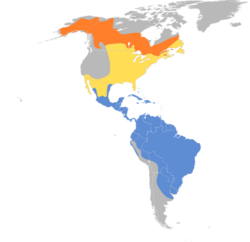Biology:Solitary sandpiper
| Solitary sandpiper | |
|---|---|

| |
| Scientific classification | |
| Domain: | Eukaryota |
| Kingdom: | Animalia |
| Phylum: | Chordata |
| Class: | Aves |
| Order: | Charadriiformes |
| Family: | Scolopacidae |
| Genus: | Tringa |
| Species: | T. solitaria
|
| Binomial name | |
| Tringa solitaria Wilson, 1813
| |

| |
| Synonyms | |
|
Helodromas solitarius | |
The solitary sandpiper (Tringa solitaria) is a small shorebird. The genus name Tringa is the Neo-Latin name given to the green sandpiper by Aldrovandus in 1599 based on Ancient Greek trungas, a thrush-sized, white-rumped, tail-bobbing wading bird mentioned by Aristotle. The specific solitaria is Latin for "solitary" from solus, "alone".[2]
Description
This species measures 18–23 cm (7.1–9.1 in) long, with a wingspan up to 50 cm (20 in) and a body mass of 31–65 g (1.1–2.3 oz).[3][4] It is a dumpy wader with a dark green back, greyish head and breast and otherwise white underparts. It is obvious in flight, with wings dark above and below, and a dark rump and tail centre. The latter feature distinguishes it from the slightly larger and broader-winged, but otherwise very similar, green sandpiper (T. ochropus) of Europe and Asia, to which it is closely related.[5] The latter species has a brilliant white rump. In flight, the solitary sandpiper has a characteristic three-note whistle. They both have brown wings with little light dots, and a delicate but contrasting neck and chest pattern. In addition, both species nest in trees, unlike most other scolopacids.
Distribution and habitat
It breeds in woodlands across Alaska and Canada . It is a migratory bird, wintering in Central and South America, especially in the Amazon River basin, and the Caribbean. It is a very rare vagrant to western Europe, and goes there in the summer–autumn period.
Subspecies
The solitary sandpiper is split into two subspecies:
- T. s. cinnamomea, (Brewster, 1890): breeds in Alaska & western Canada
- T. s. solitaria, (Wilson, 1813): breeds from eastern British Columbia to Labrador

Behaviour
As its name indicates, the solitary sandpiper is not a gregarious species, usually seen alone during migration, although sometimes small numbers congregate in suitable feeding areas. The solitary sandpiper is very much a bird of fresh water, and is often found in sites, such as ditches, too restricted for other waders, which tend to like a clear all-round view.
Breeding
The sandpiper lays a clutch of 3–5 eggs in abandoned tree nests of songbird species, such as those of thrushes. The young birds are encouraged to drop to the ground soon after hatching.[6]
Feeding
Food is small invertebrates: insects (such as mosquito larvae, young midges, grasshoppers, caterpillars and beetles), small crustaceans and molluscs (such as snails extracted from their shells),[7] sometimes small frogs (primarily as tadpoles),[8] picked off the mud as the bird works steadily around the edges of its chosen pond.
References
- ↑ BirdLife International (2018). "Tringa solitaria". IUCN Red List of Threatened Species 2018: e.T22693239A130186218. doi:10.2305/IUCN.UK.2018-2.RLTS.T22693239A130186218.en. https://www.iucnredlist.org/species/22693239/130186218. Retrieved 11 November 2021.
- ↑ Jobling, James A (2010). The Helm Dictionary of Scientific Bird Names. London: Christopher Helm. pp. 359, 390. ISBN 978-1-4081-2501-4. https://archive.org/details/Helm_Dictionary_of_Scientific_Bird_Names_by_James_A._Jobling.
- ↑ Solitary sandpiper at All about birds
- ↑ CRC Handbook of Avian Body Masses by John B. Dunning Jr. (Editor). CRC Press (1992), ISBN:978-0-8493-4258-5.
- ↑ Pereira, Sérgio Luiz; Baker, Allan J. (2005). "Multiple Gene Evidence for Parallel Evolution and Retention of Ancestral Morphological States in the Shanks (Charadriiformes: Scolopacidae)". The Condor 107 (3): 514. doi:10.1650/0010-5422(2005)107[0514:MGEFPE2.0.CO;2]. ISSN 0010-5422.
- ↑ Federation of Alberta Naturalists. (1992) Glen P. Semenchuk (ed.). The Atlas of Breeding Birds of Alberta. Edmonton, AB:Federation of Alberta Naturalists.
- ↑ "Tringa solitaria (Solitary sandpiper)". https://animaldiversity.org/accounts/Tringa_solitaria/.
- ↑ "Tringa solitaria (Solitary sandpiper)". https://animaldiversity.org/accounts/Tringa_solitaria/.
External links
- Solitary sandpiper - Tringa solitaria - USGS Patuxent Bird Identification InfoCenter
- Solitary sandpiper species account - Cornell Lab of Ornithology
- "Tringa solitaria". Avibase. https://avibase.bsc-eoc.org/species.jsp?lang=EN&avibaseid=.
- "Solitary sandpiper media". Internet Bird Collection. http://www.hbw.com/ibc/species/solitary-sandpiper-tringa-solitaria.
- Solitary sandpiper photo gallery at VIREO (Drexel University)
Wikidata ☰ Q836304 entry
 |


